Invloed van koolstofnanobuisjes en zijn derivaten op tumorcellen in vitro en biochemische parameters, cellulaire bloedsamenstelling in vivo
Abstract
Het doel van het voorgestelde werk was om de toxiciteit van geoxideerde koolstofnanobuizen (CNTox), gefunctionaliseerd door doxorubicine (CNT-Dox) en fluoresceïne (CNT-FITC) op cel- en organismeniveau te analyseren. Het cytotoxische effect van CNTox, CNT-Dox en CNT-FITC werd in vitro geanalyseerd op tumorcellen (2-D, 3D-culturen) en op Balb2/c-muizenmodel in vivo. Als resultaat werd de mogelijkheid van immobilisatie van doxorubicine op het oppervlak van CNT en gecontroleerde afgifte van doxorubicine (Dox) van het oppervlak van CNT aangetoond. Dox-immobilisatie valt samen met afnemend cytotoxisch effect CNT-Dox in vergelijking met vrije Dox. Afbraak van peptidebindingen met CNT-oppervlak leidde tot de afgifte van doxorubicine en dosisafhankelijke versterking van het cytotoxische effect van CNT's en Dox. Het gecombineerde cytotoxische effect van CNT's, Dox en trypsine op de overleving van tumorcellen werd aangetoond. Op organismeniveau werd het effect onderzocht van de verkregen nanostructuren op de toestand van het leverenzymsysteem, het eiwitmetabolisme en de celbloedsamenstelling van de proefdieren. CNTox-invloed in vivo-model was statistisch hetzelfde als controle. CNT-Dox vertoonde een lager toxisch effect op het totale organisme in vergelijking met de pure doxorubicine. Afwijkingen in de samenstelling van het celbloed wezen op een algemeen toxisch effect van CNT-Dox, maar het was gematigder in vergelijking met pure doxorubicine. Uit de verkregen gegevens hebben we geconcludeerd dat het binden van CNT's met doxorubicine het mogelijk maakt de toxiciteit van het doxorubicine op de algemene biochemische indicatoren van bloed en schendingen in de samenstelling van de bloedcellen in vivo te verminderen. Tegelijkertijd stelde het gecombineerde effect van CNT's en doxorubicine na medicijnafgifte ons in staat om een grotere werkzaamheid te bereiken bij het onderdrukken van tumorgroei in vitro.
Achtergrond
Een van de meest opvallende en veelbelovende toepassingen van koolstofnanobuisjes is de geneeskunde. Koolstofnanobuisjes (CNT's) worden gekenmerkt door unieke chemische en biologische eigenschappen [1,2,3,4,5]. CNT's hebben een groot oppervlak waardoor ze een breed scala aan biologische stoffen kunnen hechten [6]. Bovendien kunnen CNT's doordringen door celmembranen, haarvaten en zich ophopen in cellen en weefsels [7,8,9]. CNT's worden gemakkelijk door cellen geabsorbeerd en het bevordert het vermogen van CNT's om celkernen te bereiken en impliceert de mogelijkheid van gentherapie [10]. Daarom zijn CNT's aantrekkelijke vehikels voor het transport van eiwitten, antigenen, RNA/DNA-vectoren [11], vaccins en medicijnen naar de cellen [12]. Bijzondere belangstelling gaat uit naar de vooruitzichten voor het gebruik van CNT's als gepersonaliseerde drager met gecontroleerde afgifte van geneesmiddelen voor antikanker [13], antibacteriële [14] en immunologische therapie [15]. Gerichte afgifte en gecontroleerde afgifte is het eigenlijke probleem van het moderne gebruik van geneesmiddelen, vooral met cytotoxische eigenschappen. Het exacte mechanisme van geneesmiddelafgifte zorgt voor een effectieve concentratie van de werkzame stof in het doelweefsel met een minimale concentratie in andere. Het zou de dosis van het medicijn verminderen met behoud van de effectiviteit en vermindering van schade door bijwerkingen. Momenteel zijn er verschillende manieren van doelgerichte medicijnafgifte, zoals toediening met liposomen [16], polymere micellen en dendrimeren [17], biologisch afbreekbare deeltjes [18] en andere nanodeeltjes [19]. Maar recente experimenten hebben veel voordelen aangetoond van het gebruik van CNT's bij het afleveren van medicijnen in vergelijking met andere nanodeeltjes [20, 21]. Een daarvan is die CNT's met een vrij groot en actief oppervlak die gevuld kunnen worden met de gewenste chemische stof, variërend van kleine moleculen tot eiwitten, antilichamen en RNA/DNA. Open uiteinden van CNT's maken het binnenvolume en oppervlak toegankelijk voor functionalisering. Het grote oppervlak van CNT's biedt dus veel bindingsplaatsen voor verschillende soorten functionalisering. Tegelijkertijd met de vooruitzichten van CNT's, zijn er enkele problemen met de lage oplosbaarheid van CNT's, het vermogen tot aggregatie, hydrofiele eigenschappen, lange halfwaardetijd en invloed op het hele organisme [22]. Volgens de literatuur gaat de introductie van CNT's in het lichaam van proefdieren gepaard met accumulatie van CNT en zijn derivaten in de organen van het spijsverteringskanaal, milt, nieren [23], spieren [24] en longweefsel [25] . In de volgende stap beïnvloeden CNT's de activiteit van metabole en ontstekingsprocessen [25, 26], de toestand van het immuunsysteem [27] en de overleving van proefdieren [28]. Niettemin zijn deze problemen het onderwerp van actief onderzoek voor verdere vooruitgang in het gebruik van koolstofnanobuisjes. De voordelen van CNT's als nanovectoren voor medicijnafgifte zijn overtuigend aangetoond in een aantal onderzoeken. Auteurs van [29, 30] meldden dat specifieke nanobuisjes mogelijk minder schadelijk zijn dan nanodragers voor medicijnen. Er is ook aangetoond dat eenvoudige functionalisering (-OH, -COOH, -NH, PEG) [31] of inkapseling van de CNT's [22], de oplosbaarheid in water verhoogt, de biologische beschikbaarheid verbetert en de toxiciteit van CNT's vermindert. En de introductie van CNT's bij muizen met een getransplanteerde tumor kan effectief zijn tegen gericht getransformeerd weefsel en leiden tot een afname van het tumorvolume en tot een toename van de overleving van dieren [32].
Op basis van eerdere onderzoeken [33] gingen we ervan uit dat actieve antitumorstof (doxorubicine) kon worden geïmmobiliseerd op het oppervlak van peptidebindingen van koolstofnanobuisjes. De resulterende verbinding, koolstofnanobuisjes die werden gefunctionaliseerd door doxorubicine (CNT-Dox), zou de cytotoxische eigenschappen van CNT als doxorubicine (Dox) kunnen verminderen. Tegelijkertijd kan het uiteenvallen van het behandelde construct het mogelijk maken om de cytotoxische eigenschappen CNT en Dox te realiseren. Daardoor is het mogelijk om de antitumoractiviteit van beide stoffen te verhogen. Daarom was het doel van de huidige studie om het cytotoxische effect van CNTs-Dox-construct in aanwezigheid van protease (trypsine) in vitro te bepalen. We analyseerden de impact van CNT's en zijn derivaten op tumorcellen in 2D- en 3D-celmodel, in vitro. Het andere doel was om de invloed van de verkregen verbindingen (CNT's, CNTox en CNT-Dox) op de activiteit van het leverenzymsysteem, de omzetting van eiwitten en op de cellulaire bloedsamenstelling in vivo te onderzoeken. Dus realiseerden de auteurs een complexe schatting van de toxiciteit, biologische beschikbaarheid en effectiviteit van het gebruik van CNT's en hun derivaten tegen tumoren van het maagdarmkanaal.
Methoden
Cellijn van blank colonadenocarcinoom graad II carcinoom (HT29) werd in vitro gebruikt als experimenteel celmodel in 2D (monolaag) en 3D (sferoïde) systemen. De lijn werd gekocht van Bank of cellijnen en weefsels van dieren Kavetsky' Institute of experimentele pathologie, oncologie en radiobiologie NAS Oekraïne. De cellen werden behandeld in standaard celkweekomstandigheden (95% vochtigheid, 5% CO2 in de lucht; 37 °C) in DMEM vol medium met 10% FBS onder laboratorium inperkingsniveau 2.
Synthese, oxidatie en functionalisering van CNT
De initiële meerwandige koolstofnanobuisjes (MWCNT's) werden verkregen door chemische dampafzetting (propyleen en waterstof met Mo/Fe/Al2 O3 als katalysator). Gesynthetiseerde MWCNT's hadden 10-30 lagen, interne diameter 5-15 nm, externe diameter 10-60 nm, lengte 20-500 μm, specifiek oppervlak 120 m 2 /g en bulkdichtheid 5–50 g/l [33].
Zuivering van MWCNT's uit het metaal/katalysator werd uitgevoerd door HF-behandeling. Eliminatie van amorfe koolstof uit koolstofnanomaterialen werd gerealiseerd door oxidatie in lucht bij 450-500 ° C. Het ruwe monster met MWCNT's reageerde met zuurstof uit lucht en creëerde kooldioxide of koolmonoxide. Er is enige hoeveelheid koolstofafzetting verkregen nadat HF (aqua) oplossing van de katalysatordrager in lucht was geoxideerd bij 450-500 ° C. Voor deze procedure werd gedurende 130-150 minuten een luchtstroom-kwartsbuisreactor gebruikt. We analyseerden en beschreven fysische en chemische kenmerken van verkregen MWCNT's in eerder werk [33].
Scanning-elektronenspectroscopie (SEM) van MWCNT's (JEOL SL6060LA, Japan) werd gebruikt om de structurele kenmerken van MWCNT's te bepalen. Na immobilisatie van de liganden was de morfologie niet veranderd.
Oxidatie van MWCNT's
Bij de volgende stap werden de gezuiverde koolstofnanobuisjes (CNT's) geoxideerd in 70% HNO3 bij 99 °C gedurende 4 uur en vervolgens gewassen met gedestilleerd water en 10% NH4 OH-oplossing gedurende 12 uur. Als resultaat werden koolstof nanomateriaaloxiden MWCNTox (CNTox) gesynthetiseerd. Daarna werden CNT's driemaal gewassen met dH2 O tot neutrale pH. De zure plaatsen op het CNT-oppervlak werden geregenereerd met 0,1 M HCl-oplossing. De resulterende geoxideerde CNTs-ox werden gescheiden door centrifugeren, uitgebreid gespoeld en opnieuw gesuspendeerd in dH2 O water.
Voorbereiding van CNT-Dox-deeltjes
De taak van de volgende stap was om Dox-hydrochloride (Dox, Teva Nederland B.V, Nederland) op het oppervlak van MWCNT-deeltjes te immobiliseren. Om de oppervlakken van geoxideerde CNT's (200 mg) door amino-bevattende Dox-lactosemonohydraat te functionaliseren, werden ze geïncubeerd met bifunctioneel verbindingsmiddel - N-cyclohexyl-N′- (2 morfolino-ethyl) carbodiimide metho-p-tolueensulfonaat (C 1011, Sigma Aldrich , VS) gedurende 15 minuten bij kamertemperatuur (Fig. 1a). Daarna werd 100 mg DOX-lactosemonohydraat toegevoegd aan 10 ml 0,15 M fosfaatbuffer pH 6,5 aan elk nanokoolstofmateriaal. Het mengsel mocht 24 uur reageren bij 30°C. Onder dergelijke omstandigheden werden covalente bindingen tussen Dox en CNT's gevormd (figuur 1b). De samenstelling werd verzameld door centrifugatie bij 10.000 tpm en 15 min en gewassen met dH2 O driemaal. Supernatanten werden gebruikt voor detectie van de concentratie van vrij DOX met een spectrofotometer. Immobilisatie van FITS op het CNT-oppervlak werd geleverd door het schema dat wordt getoond in Fig. 2a, b.
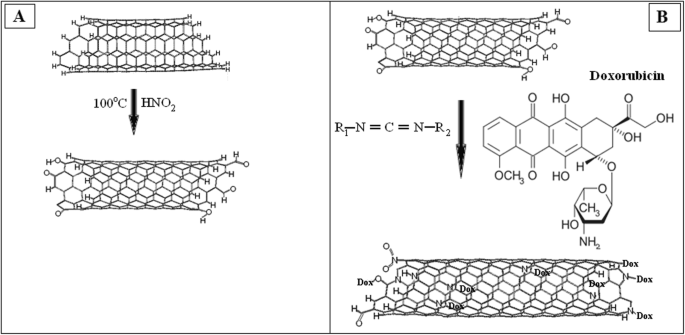
een Reactieschema van CNT's met carbodiimide. b Schema van de functionalisering van de CNT's door doxorubicine
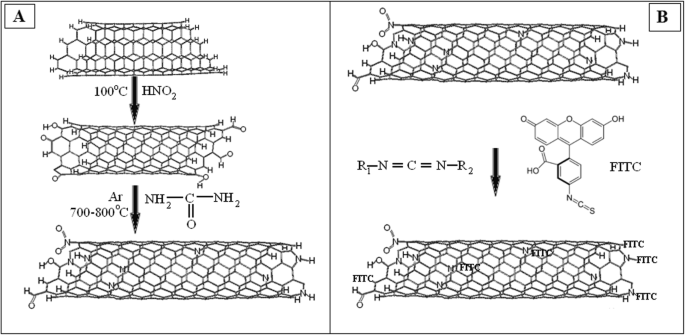
een Schema van reactie van CNT's met ureum. b Schema van de functionalisering van de CNT's door FITC
Voorbereiding van stabiele schorsingen van MWCNT's
De colloïdale suspensie van MWCNT's werd in twee fasen uitgevoerd. In de eerste fase zijn koolstofnanomaterialen onderworpen aan ultrasone behandeling in fosfaatzoutbuffer (PBS) met behulp van een ultrasone disperser UZDN-2 T. De verwerkingsmodi waren I = 10 mA, R = 22 kHz, duur:30 min. In de tweede trap werd de resulterende hydrosol gedispergeerd door centrifugatie bij kamertemperatuur. Het proces omvat verschillende centrifugatiecycli. Dus de hydrofiele oplossende SWCNTs-fractie werd op deze manier geselecteerd. Alvorens aan de suspensie gekweekte cellen toe te voegen, werden oplossingen van MWCNT's gesteriliseerd door gedurende 30 minuten te koken. Derivaten van CNT's (CNT-Dox en CNT-FITC) werden gesteriliseerd met een 100-voudige concentratie van PSGA (penicilline:streptomycine:gentamycine:amfotericine).
Zeta-potentieel van suspensies van nanobuisjes
Zeta-potentiaal van monsters werd gemeten door middel van elektroforetische lichtverstrooiing (M3-PALS). Voor metingen werd de Zetasizer Nano ZS-analysator gebruikt, vervaardigd door Malvern Instruments (Malvern, VK). Experimenten werden uitgevoerd bij 25°C met zeven herhalingen. Om de monsters te meten, werden een universele dompelelektrode (Universal Dip Cell) ZEN1002 en polystyreen cuvetten (DTS001), een lichtbron, een H-Ne 633 nm laser, gebruikt.
FTIR-spectroscopie
De chemische samenstelling van de verkregen nanomaterialen werd onderzocht met Fourier-transform infrarood (FTIR) spectroscopie. IR-spectra werden bepaald door FTS 7000e Varian FTIR-spectrometer. Monsters voor analyse werden bereid door in een molen een mengsel van ~-1 mg CNT's en 150 mg spectraal zuivere KBr te malen. Monsters werden bereid met behulp van een pers met een drukkracht van 3,0–3,5 × 10 3 kg/cm 2 . De monsters werden gedehydrateerd door 60 minuten te verwarmen op een temperatuur van 600 °C. Pre-shot spectra van KBr werden voorlopig verkregen, daarna werden ze afgetrokken van de spectra van de monsters. Alle spectra werden geanalyseerd volgens de catalogus van spectrometrische identificatie van organische verbindingen [34]. Ter vergelijking werden monsters van MWCNT's geoxideerd (CNT-O), MWCNT's gefunctionaliseerd door doxorubicine (CNT-D) en MWCNT's gefunctionaliseerd door fluorescerend label (CNT-F) gebruikt. Alle verwerking en omstandigheden, van monsters en concentratie, waren hetzelfde voor drie materialen.
Colorimetrische test van doxorubicine-afgifte van CNT-oppervlak
Om de hoeveelheid vrije Dox na immobilisatie op CNM's en de effectiviteit van de Dox-afgifte te evalueren, werd het vermogen van vrije Dox om te fluoresceren bij een golflengte van 495 nm gebruikt [35]. De actieve concentratie van Dox in Dox hydrochloride was 16,7% w /w . Voor het tekenen van de kalibratielijnen, Dox Teva 20 mg/ml met tien verdunningen tot 8 × 10 −3 mg/ml werd gebruikt. Vervolgens werd de fluorescentie van vrije Dox gemeten in supernatant van complexen DOX met CNT's door spectrofotometrische plaatlezer Multiscan (Labsystem, Finland).
Concentratie van functionele groepen in CNT-DOX, CNT-FITC-deeltjes
Voor Dox-immobilisaties, 1 g MWCNT's in 1 ml dH2 O werd gebruikt. De hoeveelheid Dox-TEVA was 100 mg (16,7 mg actieve Dox) in 1 ml dH2 O. De hoeveelheid vrije Dox in supernatant na reactie was 0,37 mg of 2,2% van actieve stoffen. We kwamen dus tot de conclusie dat 16,23 mg DOX was geïmmobiliseerd op 1 g CNTox. Voor FITC was het percentage immobilisatie laag. Vervolgens werd 8,35 mg FITC geïmmobiliseerd op 1 g CNTox in 1 ml dH2 O. Effectiviteit van functionalisering was 1,62% w /w voor CNT-DOX en 0,84% w /w voor CNT-FITC. Verdere berekening van concentraties CNT-Dox en CNT-FITC zijn gebaseerd op deze gegevens.
Cytotoxische test van CNT-derivaten op 2D- en 3D-celmodel
De cytotoxiciteit van Dox, CNT's, CNT-FITC en CNT-Dox werd geëvalueerd tegen HT29-tumorcellen met behulp van MTT-assay. MTT-test gebaseerd op omzetting van 3-[4,5-dimetltiazol-2]-2,5-difeniltetratetrazoliumzouten in formazankristallen door NAD(P)H-afhankelijke mitochondriale oxidoreductase-enzymen in levende cellen. Protocol werd beschreven door T. Mosmann [36]. In het kort, 1 × 10 4 HT29 werd gezaaid in platen met 96 putjes en 12 uur gekweekt in volledig kweekmedium. Vervolgens werd het huidige kweekmedium vervangen door kweekmedium met CNTox (monster #1), MWCNT's (monster #2), CNT-Dox (monster #3), Dox (monster #4) en CNT-FITC (monster #5) . Concentraties van monsters # 1, 2, 3, 5 waren 12,5–25–50–100–200 g/ml, voorraadconcentratie van monster #4 was 20 μg/ml, eindconcentratie van 1 tot 10 μg/ml. Cellen werden gekweekt in volledig medium en werden gebruikt als controle. Na 24 uur incubatie werden cellen geanalyseerd met MTT door colorimetrische test. Aan 100 μl celsuspensie hebben we 20 μl MTT-oplossing (5 mg/ml PBS, Sigma) toegevoegd. Daarna werden cellen gedurende 4 uur onder standaardomstandigheden met MTT geïncubeerd. Vervolgens werden de monsters gedurende 5 minuten onder 1500 g gecentrifugeerd en werd het supernatant geëxtraheerd. In totaal werden putjes toegevoegd 10 μl DMSO (Sigma) voor verdunning van MTT-kristallen en 20 μl 25 mM glycine. De absorptie van gereageerde oplossing werd gemeten bij 540 nm op spectrofotometrische plaatlezer Multiscan (Labsystem, Finland).
Generatie van meercellige tumorsferoïden
HT29-cellen multi-cellulaire tumor sferoïde (MTS) (3D-cultuur) als modelsysteem van tumormicrometastase werd gekweekt volgens een gevestigde methode die eerder werd beschreven [33]. In het kort, de celsuspensie werd geteld met Trypan-blauw en een gelijk aantal cellen geplant (5 × 10 4 cellen/ml). De 3D-celkweek werd in DMEM (Sigma, VS) medium met 10% FBS (Sigma, VS) gehouden onder standaardomstandigheden (95% vochtigheid, 5% CO2 in lucht, 37 °C). Het genereren van MTS werd uitgevoerd door technologie die in ons laboratorium is ontwikkeld. De kweek van tumorcellen werd gedurende 24 uur gehandhaafd in platen met 24 putjes bekleed met 1% agar in kweekmedium met 0,24% carboxy-methylcellulose. Voor het onderzoeken van de afhankelijkheid van de grootte en het aantal MTS van de concentratie en het type CNT's, werd MTS gegenereerd in aanwezigheid van verschillende concentraties CNT's. Voordat MTS-generatie aan de celculturen werd gedaan, werd CNTs-oplossing in PBS in kweek toegevoegd tot de eindconcentratie zoals eerder beschreven voor MTT-assay. Verdere kweek werd uitgevoerd gedurende 48 uur bij een constante rotatie van platen op een orbitale schudder (80 tpm). In de volgende fase werden microfoto-afbeeldingen gemaakt met de "donkerveld" -methode. In totaal zijn er meer dan 120 afbeeldingen gemaakt. Vervolgens werd het volume van alle MTS, die op de bestanden stonden, berekend met het gebruiksprogramma Axio Vision Rel 4.7, Zeiss. We gebruikten de formule van Rolf Bjerkvig:V = 0.4 ∙ a ∙ b 2 , waarbij geometrische afmetingen van de sferoïden (b < een ) [37]. De visualisatie van de resultaten werd uitgevoerd op een Stemy 2000C-microscoop, Zeiss.
Analyse van de impact van CNT's op het leverenzymsysteem, de eiwitomzet en op de cellulaire bloedsamenstelling in vivo
De procedures met betrekking tot de dieren en hun verzorging waren in overeenstemming met de Europese richtlijn 2010/63 EU, goedgekeurd door de lokale ethische commissies voor dierproeven (Protocol №1 21.10.2016). Om de invloed van de verkregen stoffen op de algemene toestand van de homeostase van het organisme te analyseren, werd een reeks experimenten in vivo uitgevoerd. In vivo-onderzoeken werden muizen van de Balb/2a-lijn gebruikt. Mannelijke en vrouwelijke muizen waren gelijk in de groepen, in de leeftijd van 6-8 weken, tien voor elke groep. Muizen werden gehuisvest in kooien met stalen draadtoppen en maïskolfbedden en werden in een gecontroleerde atmosfeer gehouden met een 12/12 donker/lichtcyclus, een temperatuur van 22 °C ± -3 °C en een vochtigheid van 50-70%, met vrije toegang tot voedsel en vers water. Zo werden vier groepen muizen gevormd. Groep 1:intacte dieren werden behandeld met 200 μl PBS, controle. Groep 2:muizen werden behandeld met CNTox in een dosis van 1,5 mg/kg. Groep 3:muizen werden behandeld met CNT-DOX in een dosis van 1,5 mg/kg. En in groep 4 kregen muizen doxorubicine in een dosis van 20 mg/kg. Muizen kregen CNT parenteraal in 200 μl PBS, elke 3 dagen, gedurende 4 weken. Doxorubicine werd eenmaal per 3 dagen intraperitoneaal toegediend in een concentratie van 20 mg/kg lichaamsgewicht.
Serum biochemische analyse
Een maand later werden muizen uit het experiment teruggetrokken. Hartbloedmonsters werden onmiddellijk verzameld van dode dieren. Bloed werd tegelijkertijd van 10 tot 11 uur van dieren afgenomen. Voor plasma werd bloed 40 minuten bij 37 ° C geïncubeerd en vervolgens gecentrifugeerd (20 minuten, 2000 tpm). Vervolgens werden biochemische parameters, totaal eiwit, albumine, aspartaataminotransferase (AST) en alanineaminotransferase (ALT), alkalische fosfatase (ALP), bepaald in het plasma met diagnostische kits (Cormay, Warschau, Polen). Experimenten werden uitgevoerd door uniforme laboratoriumprotocollen op de semi-automatische biochemische analysator FP-901M (Labsystems, Finland). De samenstelling van het cellulaire bloed werd bepaald op een hematologische analysator Mindray BC-3000 Plus, China.
Statistische analyse
Voor statistische analyse van 3D-cultuur werden alle celaggregaten gesorteerd in groepen op grootte van 1 × 10 −4 mm 3 tot 1 × 10 −2 mm 3 met stap in 1 × 10 −3 mm 3 . Vervolgens werd het aantal op MTS in elke groep en de mediaan van het MTS-volume voor elke groep geschat. Alle metingen werden drie keer herhaald. Voor microstatistieken die normaal verdeelde willekeurige variabelen zijn, gebruikten we de Student's-coëfficiënt voor een kleine populatie. De aangegeven p waarde was *р ≤ 0.05 of **р ≤ 0.01.
Resultaten en discussie
Scanning-elektronenmicroscopie van MWCNT's
Volgens protocol [38] was de gemiddelde diameter van CNT's 10-20 nm en was het specifieke oppervlak bepaald door argondesorptie 200-400 m 2 /G. Bulkdichtheid binnen 20–40 g/dm 3 . In het bijzonder worden de agglomeraten in de vorm van verstrengelde buizen met afmetingen van 20-500 μm verkregen tijdens een industriële CNT-productie waarbij de CVD-methode wordt toegepast (Fig. 3).
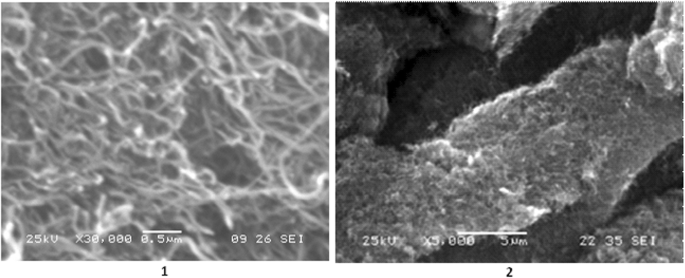
SEM-afbeeldingen van CNT's, 1) schaal 0,5 m; 2) schaal 5 m
Zetapotentieel van suspensies van nanobuisjes
CNTox en CNT duiden op een significante aggregatiestabiliteit, die direct afhangt van de waarde van de zeta-potentiaal. CNT-DOX heeft een kleinere zeta-potentiaal dan CNTox en CNT, en een hoge reproduceerbaarheid van de meting, die de homogeniteit van de deeltjes aangeeft (tabel 1). Een kleine waarde van de zeta-potentiaal van CNT-FITC kan duiden op significante deeltjesgroottes of hun kleine concentraties, zoals blijkt uit de hoge ruisverhouding bij meting.
FTIR-spectroscopie van CNT's, CNT-Dox en CNT-FITC
De bindingen tussen CNTox en doxorubicine (DOX) en fluoresceïne (FITC) werden geschat op basis van infrarood spectrale gegevens zoals aangetoond in Fig. 4.
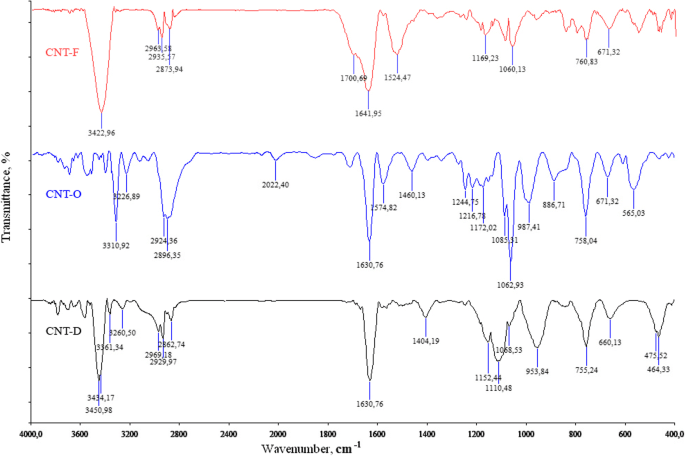
Infraroodspectra van CNTox (CNT-O), CNT-DOX (CNT-D), CNT-FITC (CNT-F)
De aanwezigheid van een sterke band op υ = 3311 cm −1 (CNT-O) en υ = 3451 cm −1 (CNT-D) toegeschreven aan de CON-H koppelingsfluctuaties, evenals de aanwezigheid van een sterke band bij υ = 1634 cm −1 (CNT-O) en υ = 1631 cm −1 (CNT-D) toegeschreven aan de O-CNH-bindingstrillingen, wat duidelijk het type amidebinding tussen CNT en Dox aangeeft. IR toonde ook de absorptie van C-H-bindingen aan, die zich op 2969-2834 cm −1 bevindt en een brede band van 1460–1407 cm −1 uit het C-O-H-fragment. We kunnen dus concluderen dat als gevolg van chemische reacties CNT's werden gefunctionaliseerd met een antitumormiddel (doxorubicine) en een fluorescerend label (FITC).
Cytotoxiciteit van CNT's in verschillende stadia van functionalisering op monolaag- en sferoïden-celgroeimodellen
De volgende stap was het bepalen van de cytotoxiciteit van geoxideerde CNT's (CNTox), CNT's gefunctionaliseerd met doxorubicine (CNT-Dox) en fluorescerend label (CNT-FITC). De resultaten van de MTT-test op monolaagcultuur van HT29 worden getoond in Fig. 5.
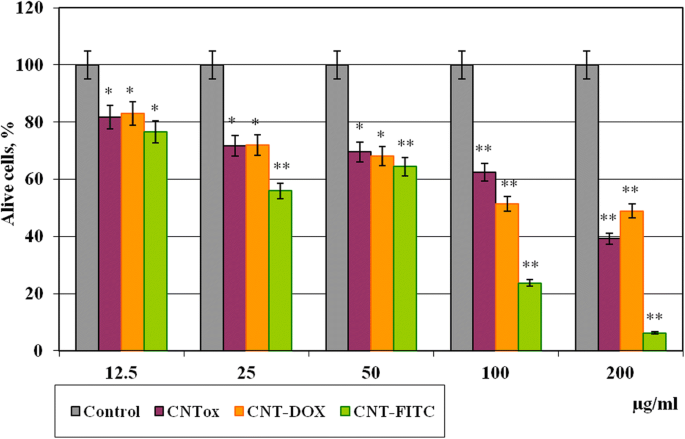
Levensvatbaarheid van tumorcellen HT29 in monolaagcultuur na incubatie gedurende 48 uur met CNT's en zijn derivaten (CNT-Dox en CNT-FITC). Statistische significantie:*р ≤ 0.05 of **р ≤ 0.01
Als resultaat werd aangetoond dat CNTox, CNT-Dox en CNT-FITC een matig cytotoxisch effect hebben bij concentraties van 12,5 μg/ml (81%). Het verhogen van de CNTox-concentratie van 25 naar 50 en 100 μg / ml leidde tot een dosisafhankelijke afname van de levensvatbaarheid van tumorcellen tot 71,8-69,6-62,5% dienovereenkomstig in vergelijking met controle. Bij een concentratie van CNTox tot 200 μg/ml nam de levensvatbaarheid van HT29 af tot 39,2%. Op dat moment vertoonde CNT-Dox bij lage concentraties (12,5-50 g/ml) geen statistisch significante cytotoxiciteit, vergeleken met CNTox. Bij hoge concentraties (200 g/ml) had CTN-Dox zelfs minder cytotoxiciteit dan CNTox (50%). Tegelijkertijd hadden CNT's, gefunctionaliseerd met fluoresceïne, een relatief hoger cytotoxisch effect op tumorcellen. Na incubatie met CNT-FITC in een concentratie van 25 g/ml, verminderde de overleving van HT29-cellen tot 55% en bij 100-200 μg/ml tot respectievelijk 23 en 7%. In dat geval speelden CNT's dus de rol van nogal inert celsubstraat. Meer dan dat, CNT's geïmmobiliseerd Dox en verminderde Dox cytotoxiciteit. In eerdere studies [33] hebben we aangetoond dat primaire nanobuisjes hydrofobe eigenschappen hebben, een matig cytotoxisch effect hebben en de vorming van een groot aantal cellulaire aggregaten stimuleren. Volgens de literatuur [39] verandert de oppervlaktelading van CNT's tijdens de oxidatie. CNT's worden hydrofiel en het leidt tot de vorming van kleinere aggregaten en verhoogt het cytotoxische effect van CNT's. De gegevens die we in eerdere studie ontvangen, bevestigen deze tendens. CNTox verminderde de overleving van tumorcellen met ten minste 60% in vergelijking met controle, CNT-Dox met 45% en CNT-FITC met 97% (bij 200 μg/ml). Verklaring van de verkregen gegevens kan zijn in rapporten van de andere auteurs dat functionele liganden in de meeste gevallen het oppervlakte-zeta-potentieel van CNT's veranderen, de oplosbaarheid van CNT's stimuleren en de celpenetratie van CNT's verhogen [40]. Het vermogen van CNT's om aggregaten te vormen na oxidatie en functionalisering neemt af, terwijl de permeabiliteit door het celmembraan toeneemt en de reactiviteit van cellulaire organellen toeneemt. Meer dan dat, CNT-Dox heeft bij hoge concentraties een lager cytotoxisch effect dan CNTox. Tegelijkertijd kan volgens de verkregen gegevens worden aangenomen dat de peptidebinding doxorubicine op het oppervlak van de CNT houdt. Peptidebinding tussen CNT's en Dox is voldoende stabiel in celkweekomstandigheden. Het breekt niet af en neemt doxorubicine in inactieve vorm in. Tegelijkertijd wordt fluoresceïne-natriummoleculair (C20 H12 O5 ), een ligand ter grootte van 332.311 g/mol, dissocieert vrij gemakkelijk van het oppervlak van de CNT's en komt de cellen binnen. In de resultaten zijn er onomkeerbare schendingen van DNA-structuren, kernen en mitochondriën [41].
Om de cytotoxiciteit van CNT's en zijn derivaten en de impact op de adhesieve eigenschappen van tumorcellen te verifiëren, werd het gebied van de HT29-cel 2D-kolonies geanalyseerd. De resultaten worden getoond in Fig. 6. Er werd aangetoond dat CNT's en hun derivaten een invloed hebben op het adhesief vermogen van tumorcellen en de vorming van tumorcelkolonies in monolaagcultuur. Incubatie van tumorcellen met CNTox (monster # 1) in concentraties van 12,5, 50,0 en 200 μg/ml leidde tot een dosisafhankelijke afname van 2D-celkolonies met 55,2%, 57,8% en 78,3% dienovereenkomstig, vergeleken met controle. Tegelijkertijd veroorzaakte het monster van CNT-Dox (monster # 3) in dezelfde concentraties niet zo'n effect. Het gebied van 2D-kolonies nam af met respectievelijk 34,8%, 61,6% en 82,4%. De CNT-FITC (monster #5) vertoonde de grootste invloed op tumorcellen in monolaagcultuur. Het gebied van 2D-kolonies na incubatie met CNT-FITC nam af met respectievelijk 59,8%, 85,2% en 89,8%. Opgemerkt moet worden dat de verkregen resultaten dezelfde tendens hebben als de MTT-assay. Maar de resultaten van de MTT-analyse toonden niet zo'n significant cytotoxisch effect. De resulterende discrepanties kunnen het gevolg zijn van niet-cytotoxische effecten van CNT's op de celkolonie en, gedeeltelijk, van een anti-adhesieve invloed. Eerder hebben we aangetoond dat CNT's minder cytotoxisch vermogen hebben dan anti-adhesie. Volgens onze gegevens stimuleren CNT's de migratie van tumorcellen naar de suspensiefractie en de vorming van meercellige tumorsferoïden (MTS). De gevoeligheid van cellen voor antitumormiddelen in monolaag- en sferoïde culturen is anders. Daarom hebben we in de volgende stap de vorming van MTS door tumorcellen HT29 in aanwezigheid van CNTox, CNT-Dox en CNT-FITC onderzocht. De concentraties van CNT's waren hetzelfde als in eerdere experimenten. In figuur 7 werd aangetoond dat CNTox (monster # 1) de vorming van MTS kan stimuleren. Verhoging van de CNTox-concentratie gaat gepaard met een dosisafhankelijke toename van het mediane volume van MTS. Bij concentratie CNTox van 12,5, 50, 200 g/ml, neemt het mediane volume van MTS toe van 1,79 tot 2,18 en 10,98 mm 3 ; het is bijna tien keer. Derivaten van CNT's veroorzaken geen dergelijk effect op tumorcellen. CNT-Dox (monster # 3) stimuleert de vorming van MTS in 2,83 keer. Tegelijkertijd leidt incubatie van 3D-tumorcelcultuur met CNT-FITC (monster #5) tot een 2,4-voudige afname van het MTS-volume.
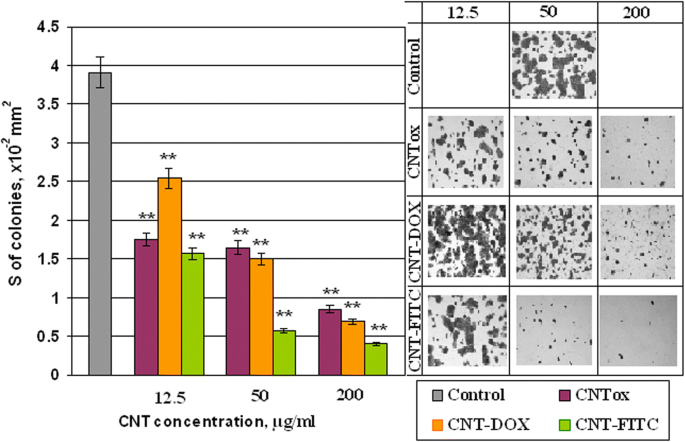
Het gebied van kolonies van HT29-tumorcellen in monolaagcultuur die werd geïncubeerd met CNTox (# 1), CNT-Dox (# 3), CNT-FITC (# 5). Statistische significantie:*р ≤ 0.05 of **р ≤ 0.01
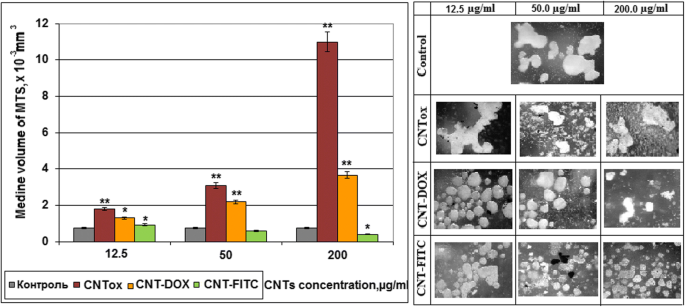
De mediaan van het volume van meercellige tumorsferoïden. MTS werden gegenereerd in aanwezigheid van CNTox (monster #1), CNT-Dox (monster #3), CNT-FITC (monster #5). Statistische significantie:*р ≤ 0.05 of **р ≤ 0.01
Het is opmerkelijk dat CNT-Dox in de meeste experimenten niet zulke cytotoxische effecten op tumorcellen heeft, zowel in 2D als in 3D-cultuur, die kunnen worden vergeleken met het effect van een enkele doxorubicine. The mechanism of cytotoxic action of doxorubicin is based on penetration into the cell nucleus and intercalation between nucleotide pairs, violation of replication and DNA repair, protein synthesis and, as a result, cell death. The cause of the reduction of cytotoxic effect of the CNT-Dox may be the binding of the doxorubicin with CNT surface through peptide bonds. It prevents Dox dissociation from CNT surface and Dox penetration into the cell and cellular organelles. This fact may let to deliver the compound to certain tissues without causing a negative effect on “non-target” objects.
In this case, the next step of the study was controlled release of doxorubicin. For peptide bonds breaking, we used the commonly known peptidase trypsin as the release agent. The effect of trypsin on the Dox release from the surface of the CNT was investigated by spectral analysis. Since the free doxorubicin has a fluorescence peak at 495 nm, bounded doxorubicin has no such ability. It was analyzed how the increasing of trypsin concentration affected on concentration of free doxorubicin. The results are shown in our previous work [42]. Shortly, it was demonstrated that increasing the concentration of 0.05% trypsin from 11 to 20% in culture medium contributed to an increasing the concentration of free doxorubicin from 3.13 to 6.55 μg/ml. A further increasing the concentration of trypsin to 60% did not lead to increasing in free doxorubicin. However, the concentration of trypsin by about 66% stimulated release again and led to increasing the concentration of doxorubicin in two times, to 11.38 μg/ml. Thus, it was concluded that 0.05% trypsin has several effective concentrations. Under these conditions, peptide bonds between doxorubicin and CNT were broken and doxorubicin was released. Therefore, to analyze how CNT-Dox influence the tumor cells after Dox release, we incubated tumor cells in the w/o fetal bovine serum (FBS) nutrient medium with trypsin and in the presence of CNT-Dox. The survival of tumor cells was determined using the MTT test. The ratio of the nutrient medium, trypsin, concentration of CNT-Dox, and doxorubicin are given in Table 2. The results of incubation HT29 during 48 h are demonstrated on Fig. 8. Cell viability in the presence of trypsin—blue columns, alone doxorubicin—orange columns, and CNT-Dox with trypsin—pink columns. In results, it has been found that the simultaneous use of trypsin and CNT-Dox significantly increased the cytotoxic effect of CNT and doxorubicin compared to the separately use of these substances. So doxorubicin alone at concentrations from 0.05 to 1.0 μg/ml causes a dose-dependent decreasing the percentage of living HT29 cells from 7.18 to 45.7% relative to control (Fig. 8, orange columns). Incubation of CNT-Dox at concentrations of 20.0 to 1.25 μg/ml with trypsin at concentration from 0 t0 70% led to a dose-dependent decreasing in the percentage of living cells from 80.9 and 99.8% respectively (Fig. 8, pink columns). At the same time, incubation with trypsin alone leads to decreasing percentage of living cells only by 34.0–42.0% (Fig. 8, blue columns). Thus, we can conclude that we observe the synergistic effect of CNT-DOX and trypsin. Each individual component has a small cytotoxic effect on cells, and together the cytotoxic potential of substances increases several times.
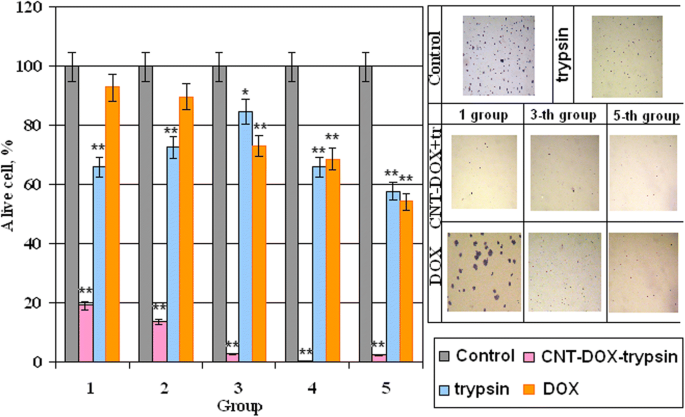
Percentage of alive cells HT29 after 48 h of incubation in the presence of trypsin, doxorubicin, CNT-Dox. Statistical significance:*р ≤ 0.05 or **р ≤ 0.01
As functional groups (Dox) were attached to CNTs surface by peptide bonds as, in vivo Dox release will be realized in organs of the gastrointestinal tract with an increased content of proteases, peptidases. In organism, proteases are used for various metabolic processes. Acid proteases secreted into the stomach (such as pepsin) and serine proteases present in duodenum (trypsin and chymotrypsin) enable us to digest the protein in food [43]. Other proteases are present in leukocytes (elastase, cathepsin G) and play several different roles in metabolic control. This is one of the fastest “switching on” and “switching off” regulatory mechanisms in the physiology of an organism. By complex cooperative action, the proteases may proceed as cascade reactions, which result in rapid and efficient amplification of an organism’s response to a physiological signal. Therefore, the authors suggest that CNT-Dox construction will be the most effective in the case of stomach, pancreas, liver, and small intestine cancer localization in case of parenteral administration of drug.
Influence of CNTs and Their Derivatives on Cell Blood Composition, Hepatic Enzyme System, and Proteins Turnover In Vivo
To determine the impact of the CNTox and CNT-Dox on the protein metabolism and the state of the hepatic enzyme system, the level of albumin (Al), total protein (Tp), alanine aminotransferase (ALT), aspartate aminotransferase (AST), and alkaline phosphatase (ALP) was determined. Data are given in Fig. 9a, b. As a result, it was noted that CNT-Dox and Dox have influence on the hepatic enzymes activity, namely on the AST and ALP. AST level increased in mice serum from 1 group for 21.6%, 2 group for 93.9%, and 3 group for 126.4% compared with control. At the same time, the activity of ALP increased in mice serum from 1 group for 23.5%, 2 group for 119.1%, and 3 group for 147.8%. CNTox administration did not show statistically significant changes in AST, ALT, and ALP levels. In addition, it should be noted that CNTox, Doxorubicin, and CNT-Dox slightly increased the level of total protein in the blood of experimental animals. So, we found that systematic introduction of CNTox have not influence on mice serum enzyme profile. And opposite, administration of CNT-Dox and Dox had toxicity influence and induced a chronic hepatic damage. Notably, symptoms of hepatitis had more manifestation after Dox treatment than CNT-Dox. To determine possible inflammatory processes and systemic effects of CNTox, CNT-Dox on the state of blood cells composition, it was analyzed the blood cell formula of the experimental animals. The results are shown in Table 3. Obtained data are in good agreement with the well-known manifestations of doxorubicin’s hematological toxicity:anemia (decreased red blood cells, hemoglobin, hematocrit), thrombopenia (platelet count), neutropenia (decrease in the number of granulocytes). Interestingly, that it was demonstrated the same direction of the changes of practically all hematological parameters in the 1 (CNTox), 2 (CNT-Dox), and 3 (Dox) groups of animals. However, the change in the 2 and 3 groups of animals was statistically significant accordingly to control and 1 group. In the 2 group (CNT-Dox), it was found pronounced decreasing of the monocyte content related to the system of phagocyte mononuclear cells and cell’s immune response (9.5% and 0.12 × 10 9 /l in control, 4.6% and 0.06 × 10 9 /l in 2 group, and 4.55 and 0.05 × 10 9 /l in 3 group). Animals of 2 and 3 groups demonstrated reducing the content of granulocytes (neutrophils) (12.6 and 0.16 × 10 9 /l in control and 8.5% and 0.2 × 10 9 /l in 2 group and 8.05 and 0.16 × 10 9 /l in 3 group). The number of lymphocytes, both in percentage and absolute, increased in 2 and 3 groups (77.9% and 0.97 × 10 9 /l in control and 86.9% and 2.0 × 10 9 /l in 2 group and 87.8% and 2.3 × 10 9 /l in 3 group). The main function of the lymphocytes is recognition of the antigen and participation in the adequate immunological response of the body. T lymphocytes perform regulatory and effectors functions. B lymphocytes take part in humoral immunity, providing immunoglobulins in response to stimulation of other people’s antigens. So, it can be assumed that an increase in the index of lymphocyte content in experimental 1, 2, and 3 groups can be associated with the introduction of foreign antibodies (CNTs) and/or tissue distraction [44]. Some decrease in the absolute number of leukocytes in 2 (1.2 × 10 9 /l) and 3 (0.85 × 10 9 /l) groups compared with the 1 group of animals (2.0 × 10 9 /l) can be regarded as the result of a gradual accumulation of the reversal of toxic effects of Dox. It is described the reaction of WBC in experimental animal groups as well-known toxic hematologic impact from doxorubicin in the development of leucopenia. The analysis of indicators reflecting the number and state of RBC (erythrocytes and hemoglobin) also showed the same trend of misbalance in the 2 and 3 groups of animals. Statistically significant thrombocytopenia and anemia are more indicative in animals of 2 and 3 groups:the number of erythrocytes (5.54 × 10 12 /l in control, 3.97 × 10 12 /l in 2 group, and 3.12 × 10 12 /l in 3 group), the amount of hemoglobin (78 g/dl for intact animals, 55.5 g/dl for 2 group, and 46.2 g/dl for 3 group), hemoglobin (25.25% for intact animals and 16.75% for 2 group and 15.12% for 3 group). The amount of erythrocytes decreased but the average content of hemoglobin in one erythrocyte did not decrease. And, as a result, concentration of hemoglobin per one erythrocyte increased. Analysis of the RBW counts let us suggest that in 2 and 3 group of animals, there are several processes:decreasing the formation of erythrocytes in the bone marrow, the acceleration of erythrocyte destruction, the violation of the structure of membranes of red blood cells, and molecular defects (oxidation) of hemoglobin. Thrombocytopenia (27 × 10 9 /l in intact animals, 14.0 × 10 9 /l in 2 group, and 12.05 × 10 9 /l in 3 group), a dose-dependent reversible myelosuppression, leucopenia and granulocytopenia (neutropenia) are the predominant manifestations of doxorubicin hematologic toxicity and is the most common acute dose-limiting toxicity of this drug. The direction of changes in the platelet content in the blood of experimental animals treated with CNTox and CNT-Dox is the same; however, significantly more pronounced in the group of animals receiving free Dox.
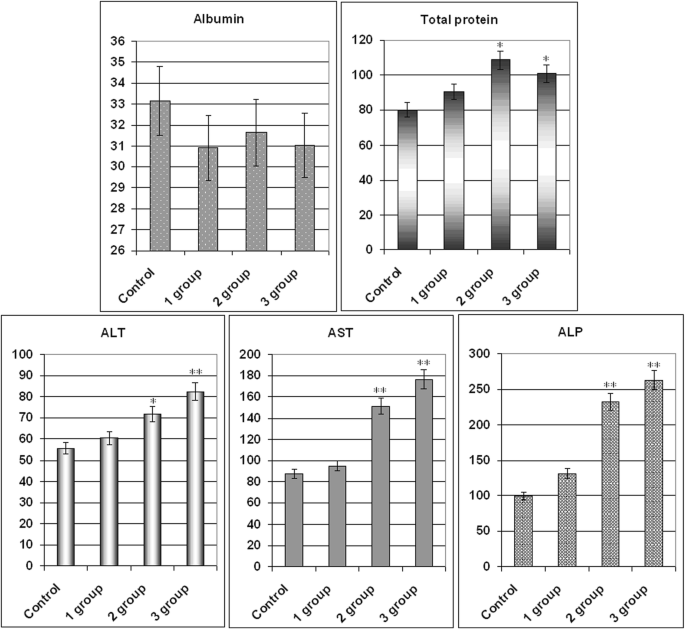
Monitoring of clinical parameters following CNTox (1 group), CNT-DOX (2 group), free DOX (3 group) administration in Balb/2a mice. Mice were treated by CNTox, CNT-DOX, DOX every 3 days during 4 weeks, in concentrations:CNT—1.5 g/kg and Dox—20 mg/kg of weight. Each experiment was done in triplicate. Statistical significance:*р ≤ 0.05 or **р ≤ 0.01. ALT alanine transferase, AST aspartate transferase, AP alkaline phosphatase
Thus, according to our results from in vivo experiments, it was demonstrated that systematic introduction of CNTox have not influence on mice serum enzyme profile and protein turnover. And opposite, administration of CNT-Dox and Dox had toxicity influence and induced a chronic hepatic damage. More than that, dose-dependent reversible myelosuppression, leucopenia, and granulocytopenia (neutropenia) was shown for the group of animals receiving free Dox. This predominant manifestation of hematologic toxicity was less pronounced in the group of animals receiving free CNT-Dox and CNTs. So, we can assume that, in the case of parenteral administration of CNT-Dox under action of gastric juice peptidases, CNT-Dox particles breaks up into free CNT and Doxorubicin. After that, Doxorubicin enters to the stomach cells and partly in the bloodstream. That also causes the specified effect on blood cells composition. For modeling Dox release in vivo, trypsin were used in vitro.
One of the goals of this investigation was to minimize the side effects of carbon vehicle on the body. Previously, the authors demonstrated that CNTs may be a potential threat to tumor development due to its ability to stimulate cell migration and support cells in suspension fraction [33]. In this case, CNTs themselves play a role of artificial extra cellular matrix. Another way CNTs can stimulate suspension cells to aggregation. If this process will be coincident with antitumor drug accumulation on CNTs surface, CNTs will attract substrate-independent cells and kill them. Simultaneously, it was found that pure CNTs did not have statistically significant cytotoxicity to tumor cells. So, CNTs alone are not dangerous as cytotoxic agents and can act as carrier for antitumor drugs to target cells. Then, studies were conducted to the functionalization of the CNTs by antitumor antibodies. It was demonstrated that CNTs are able to carry on the surface not only the Dox but also specific tumor antibodies—anti EGFr [42]. Under the action of trypsin, Dox was released and realized strong cytotoxic effect on tumor cells. Recent studies have shown the synergy cytotoxic effect of CNTs and Doxorubicin after release from CNT-Dox construct in the presence of trypsin. Such effect was not demonstrated by CNTs and Dox separately. Therefore, the benefits from the use of CNTs seems in the usage CNTs as vehicle for antitumor antibody and drug. On the other hand, the negative effects of Doxorubicin, like many other early antitumor drugs, are totally cytotoxic effects. Binding of the Dox to the CNTs partially blocks it. This effect allows ensuring local accumulation of the Dox in the focus of tumor activity with subsequent release and action. Thus, greater efficacy can be achieved with a smaller dose of administration. This effect can be achieved only if there are tumor-specific antibodies on the surface of the CNTs. The possibility of creating such construct was demonstrated by the authors in previous work. Undoubtedly, that CNTs dissemination, accumulation, and Dox effective should be tested on mixed culture in vitro and on a tumor model in vivo. For this purpose, synthesized CNT-FITC was created and conducted. The ability of the CNTs to act as an extra-cellular matrix and the significance of this process for the “tumor-body” system should be tested on the animal model. The effectiveness of the drug will be investigated on the model of Ehrlich carcinoma and colon rectal carcinoma [44]. The distribution of CNTs in the tissues of the body will be investigated using the construct created by the CST-FITC, as was mentioned in this work. The accumulation of CNTs in the tissues of the organs of the gastrointestinal system, namely the stomach, liver, and intestines, will be analyzed by histological assay. These studies are already conducted by the authors.
According to Shang-Lin Wang [4] and our data, free doxorubicin causes similar side effects, but more pronounced than CNT-Dox. Other authors reported that toxicity effect of CNTs depends on way of administration, dose, and time of exposure and varies according to the size and type of the cells [45,46,47,48,49]. Settling of CNTs in the tissues of the liver, kidneys, and stomach with prolonged exposure can cause oxidative stress, DNA damages, compromise cell proliferation, necrosis of tissues, and chronic inflammation [50]. According to Manna [51], CNTs can cause oxidative stress and compromise cell proliferation. In the case of in vitro studies, the cytotoxicity of CNT highly depends on the degree of CNTs purification, functionalization, size, and surface charge [52,53,54,55]. According to our results and previous data, the obtained CNTs did not demonstrate a significant cytotoxic effect [33]. More than that, our data let us suggest that there is a combined cytotoxic effect of CNTs and DOX that occurs as in vitro. That is why we assumed that obtained CNTs can be used against tumor cells, in case of the target accumulation of CNTs/CNT-Dox in tumor tissue. However, mechanisms of the cytotoxic effect of CNTs are not completely clear. Some authors suggested that CNT particles activate NF-kappaB pathway depending on the dose and that the mechanism of activation was due to activation of stress-related kinases [51]. Other authors reported that CNTs have a direct pro-apoptotic effect in vitro in different cancer cell lines and tumor cells obtained from surgical specimens [56], CNTs able to modify fatty acids in cell membranes [57] or erythrocyte membrane damage [58]. For further investigation of accumulation CNTs in cells and tissue, we plan to use CNT-FITC composite.
Other unclear questions are as follows:what is the prolonged impact of CNTs/CNT-Dox on organism level and how does it stimulate accumulation CNTs/CNT-Dox in tumor tissue? To investigate the influence of chronical introduction of CNTs/CNT-Dox, long-time studies on model of transplanted or initiated tumors of various localizations will be realized. Other authors analyzed the distribution of nanotubes throughout the body of mice after pulmonary exposure [59]. In results, accumulation of MWCNTs was documented in several organs, including notably the white pulp of the spleen and the bone marrow. The CNTs usually deposit in the liver, spleen, or lungs after they have served their purpose from where they are expelled gradually out of the body through the renal excretion route [60]. Zhao and Liu reported that accumulation of CNTs in the body can lead to granulomatous inflammation or alveolar septal thickening. Zhuang Liu et al. reported that SWNT-PTX affords higher efficacy in suppressing tumor growth than clinical Taxol® in a murine 4T1 breast-cancer model, owing to prolonged blood circulation and tenfold higher tumor paclitaxel (PTX) uptake by SWNT delivery likely through enhanced permeability and retention [61]. Accumulation of CNTs in the target tissue can be enhanced by placing on the CNTs surface specific antibodies which over expressed by tumor cells. The possibility of using antibodies for the targeted delivery of nanostructured preparations has been described by many authors [62, 63].
Conclusion
In 2D culture CNTox concentration from 25 to 50 and 100 μg/ml led to dose-dependent decreasing the viability of tumor cells to 71.8–69.6–62.5% accordingly compared with control. At concentration of CNTox up to 200 μg/ml, the viability of HT29 decreased to 39.2%. At that time, CNT-Dox at concentrations 12.5–25–50 μg/ml did not show statistically significant cytotoxicity, compared with CNTox. At high concentrations (200 μg/ml), CTN-Dox had even less cytotoxicity than CNTox (50%). After incubation with CNT-FITC in concentration of 25 μg/ml, HT29 cell survival reduced to 55% and at 100–200 μg/ml to 23 and 7% respectively. In 3D culture, increasing of CNTox concentration is accompanied with dose-dependent increasing of median volume of MTS. At concentration CNTox from 12.5, 50, 200 μg/ml median volume of MTS increases from 1.79 to 2.18 and 10.98 mm 3 . CNTs-Dox and CNT-FITC did not cause such effect on tumor cells. Doxorubicin alone at concentrations from 0.05 to 1.0 μg/ml causes a dose-dependent decrease in the percentage of living HT29 cells from 7.18 to 45.7% relative to control. Incubation CNT-Dox at concentrations of 20.0 to 1.25 μg/ml with trypsin at concentration from 0 to 70% led to a dose-dependent decreasing the percentage of living cells from 80.9 and 99.8% respectively. At the same time, incubation with trypsin alone leads to decreasing percentage of living cells only by 34.0–42.0%. So, the synergistic effect of CNT-DOX and trypsin was observed. Each individual component has a small cytotoxic effect on cells, and together the cytotoxic potential of substances increases several times. In vivo, systematic introduction of CNTox have not influence on mice serum enzyme profile. And opposite, administration of CNT-Dox and Dox had toxicity influence and induced a chronic hepatic damage, thrombocytopenia, a dose-dependent reversible myelosuppression, leucopenia, and granulocytopenia (neutropenia). Notably, symptoms of hepatitis had more manifestation after Dox treatment than CNT-Dox.
So, the possibility of targeted delivery and controlled release of any highly toxic drug with the use of CNT depends on strategies of reducing toxicity of CNTs and realizing potential of CNTs and anti-tumor drugs “in right place in right time.” According to the data obtained by authors and literature, it is possible. Our data support the assumption that this approach allows to reduce toxicity of the doxorubicin on the general biochemical indicators of blood and violations in the blood cells composition. At the same time, doxorubicin releasing is realized under certain conditions. And combined effect of CNTs and doxorubicin let us achieve greater efficacy in suppressing tumor cell growth in vitro.
Afkortingen
- Al:
-
Albumin
- ALP:
-
Alkalische fosfatase
- ALT:
-
Alanine aminotransferase
- AST:
-
Aspartate aminotransferase
- CNT-Dox:
-
Carbon nanotubes which were functionalized by doxorubicin
- CNT-FITC:
-
Carbon nanotubes which were functionalized by fluorescein
- CNTox:
-
Oxidized carbon nanotubes
- CNTs:
-
Koolstof nanobuisjes
- Dox:
-
Doxorubicine
- FTIR:
-
Fourier-transformatie infrarood spectroscopie
- MTS:
-
Multi-cellular tumor spheroid
- MWCNTs:
-
Multi-walled carbon nanotubes
- PTX:
-
Paclitaxel
- Tp:
-
Total protein
Nanomaterialen
- Cyclocarbon maken en in beeld brengen
- Elektrodepositie van SnO2 op FTO en de toepassing ervan in planaire heterojunctie perovskiet-zonnecellen als een elektronentransportlaag
- In vitro onderzoek naar de invloed van Au-nanodeeltjes op HT29- en SPEV-cellijnen
- Bioveiligheid en antibacterieel vermogen van grafeen en grafeenoxide in vitro en in vivo
- 5-aminolevulinezuur-squaleen nanoassemblages voor tumorfotodetectie en therapie:in vitro studies
- Magnetic Gold Nanoparticle-Labeled Heparanase Monoclonal Antibody en de daaropvolgende toepassing voor Tumor Magnetic Resonance Imaging
- Invloed van Ag-nanodeeltjes met verschillende afmetingen en concentraties ingebed in een TiO2-compacte laag op de conversie-efficiëntie van perovskiet-zonnecellen
- De effecten van geïnhaleerde meerwandige koolstofnanobuisjes op bloeddruk en hartfunctie
- De giftige waarheid over koolstofnanobuisjes in waterzuivering:een perspectief
- Antiproliferatief en apoptose-triggerend potentieel van op paclitaxel gebaseerde gerichte lipide nanodeeltjes met verbeterde cellulaire internalisatie door transferrinereceptoren - een onderzoek in le…
- Een nieuw up-conversiemateriaal van Ho3+-Yb3+-Mg2+ tri-gedoteerde TiO2 en zijn toepassingen op perovskiet-zonnecellen



